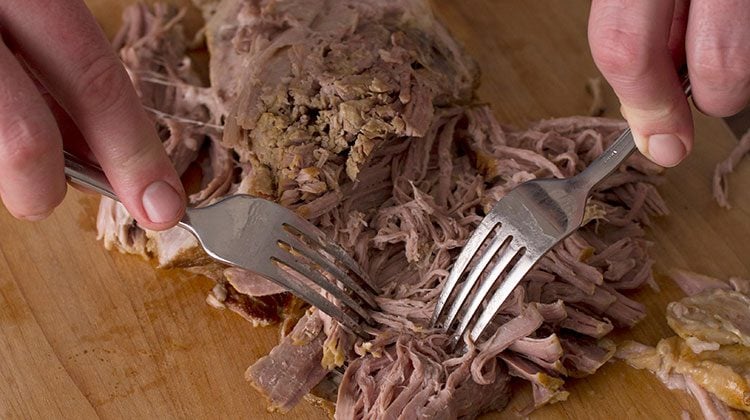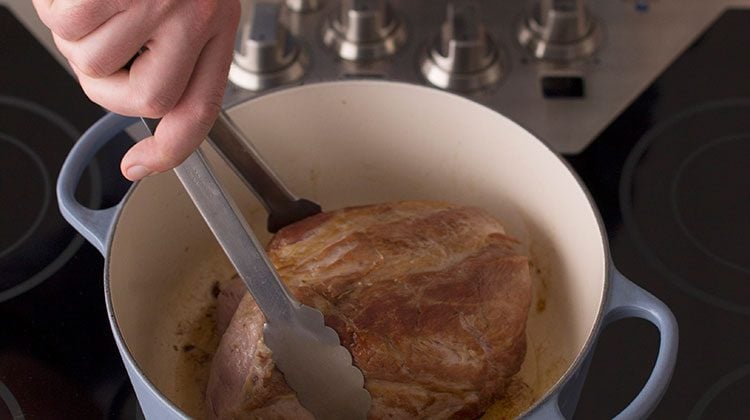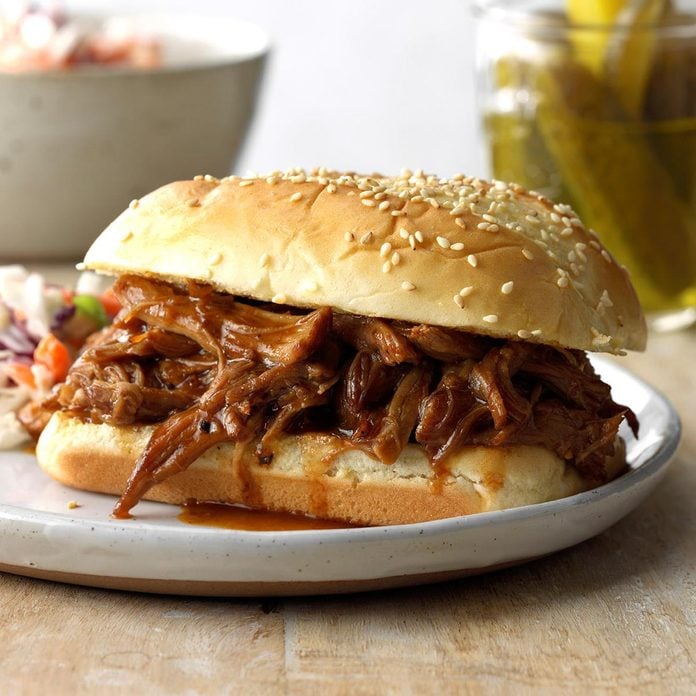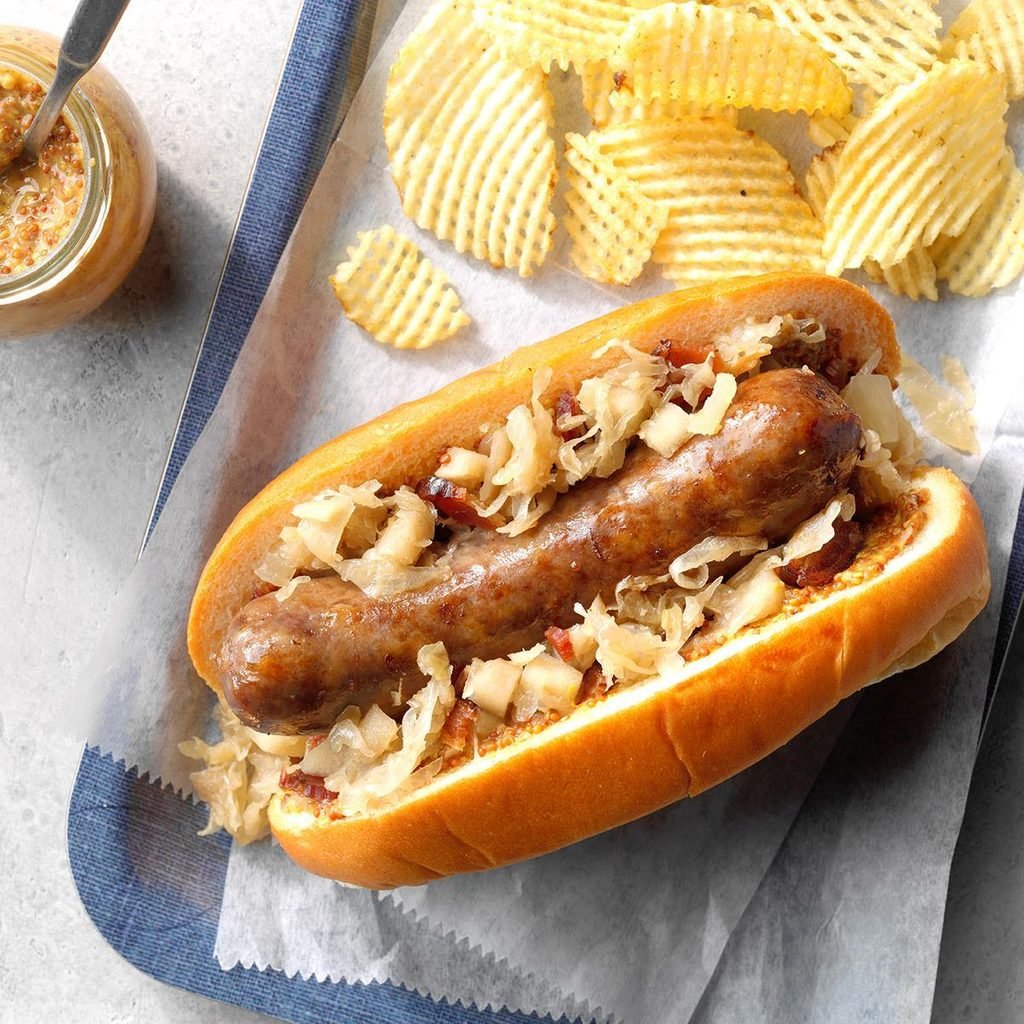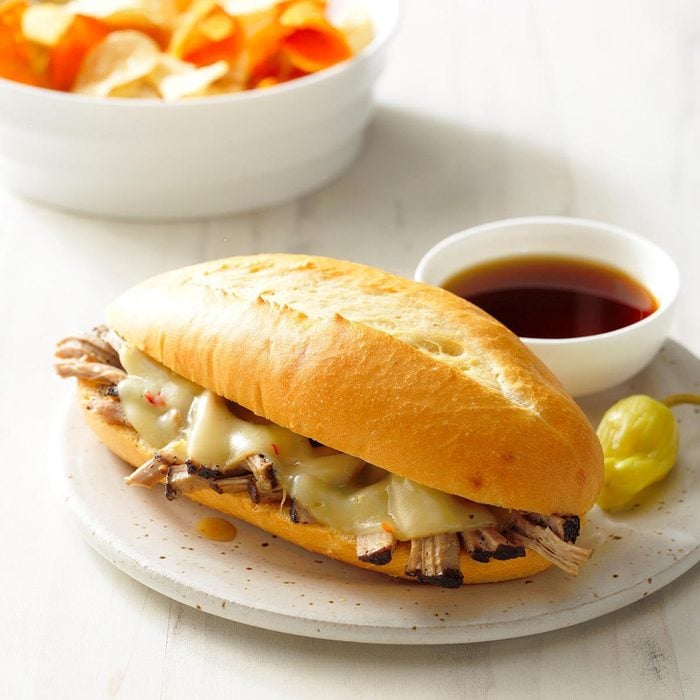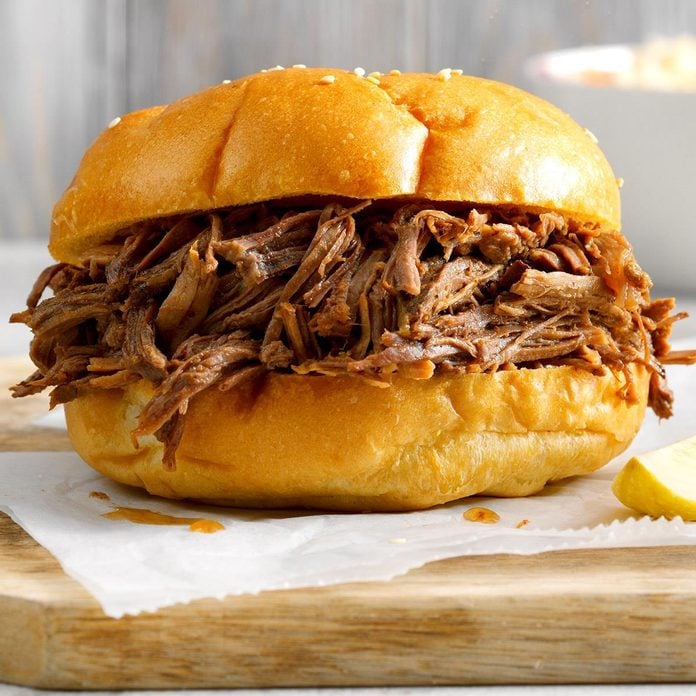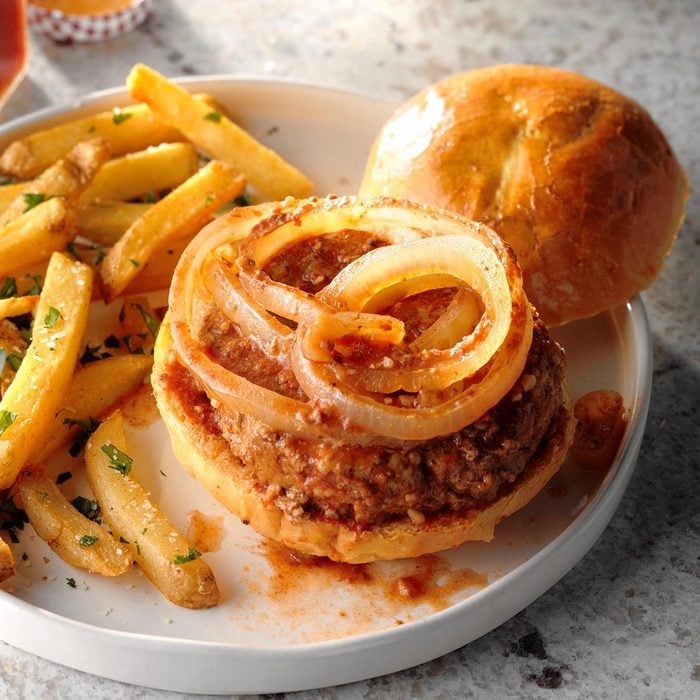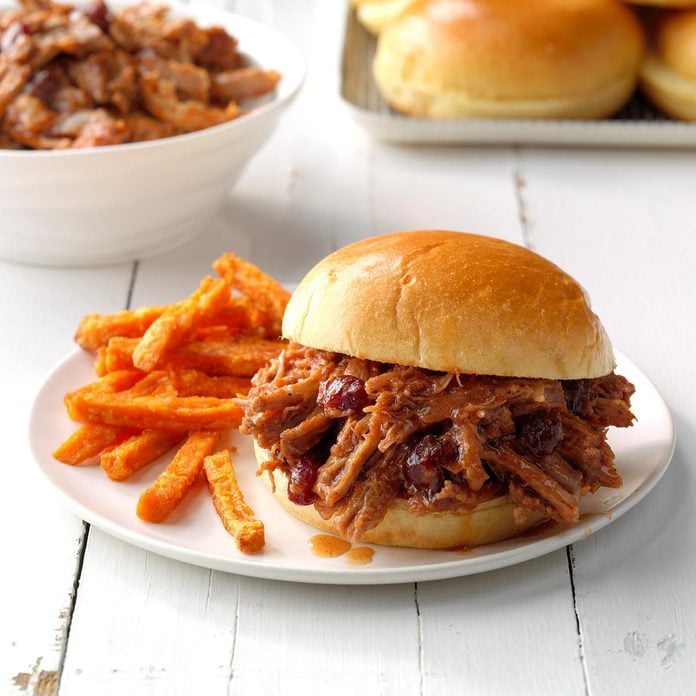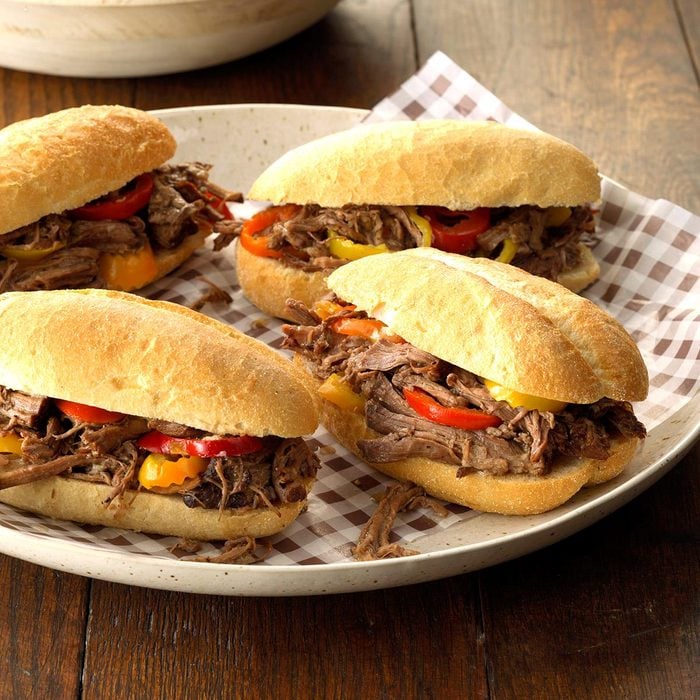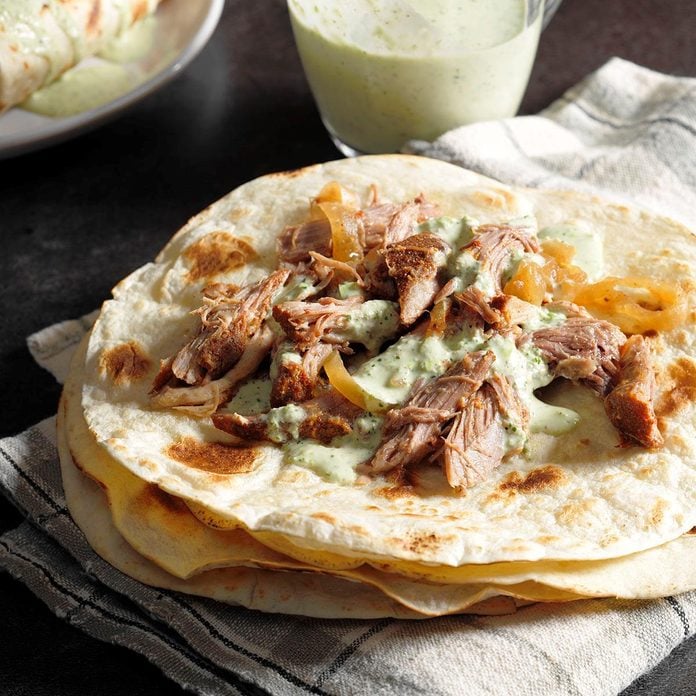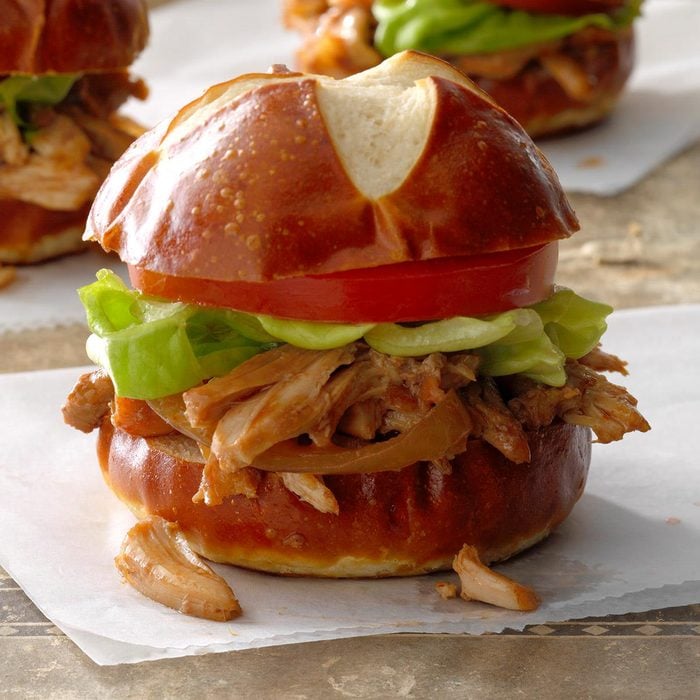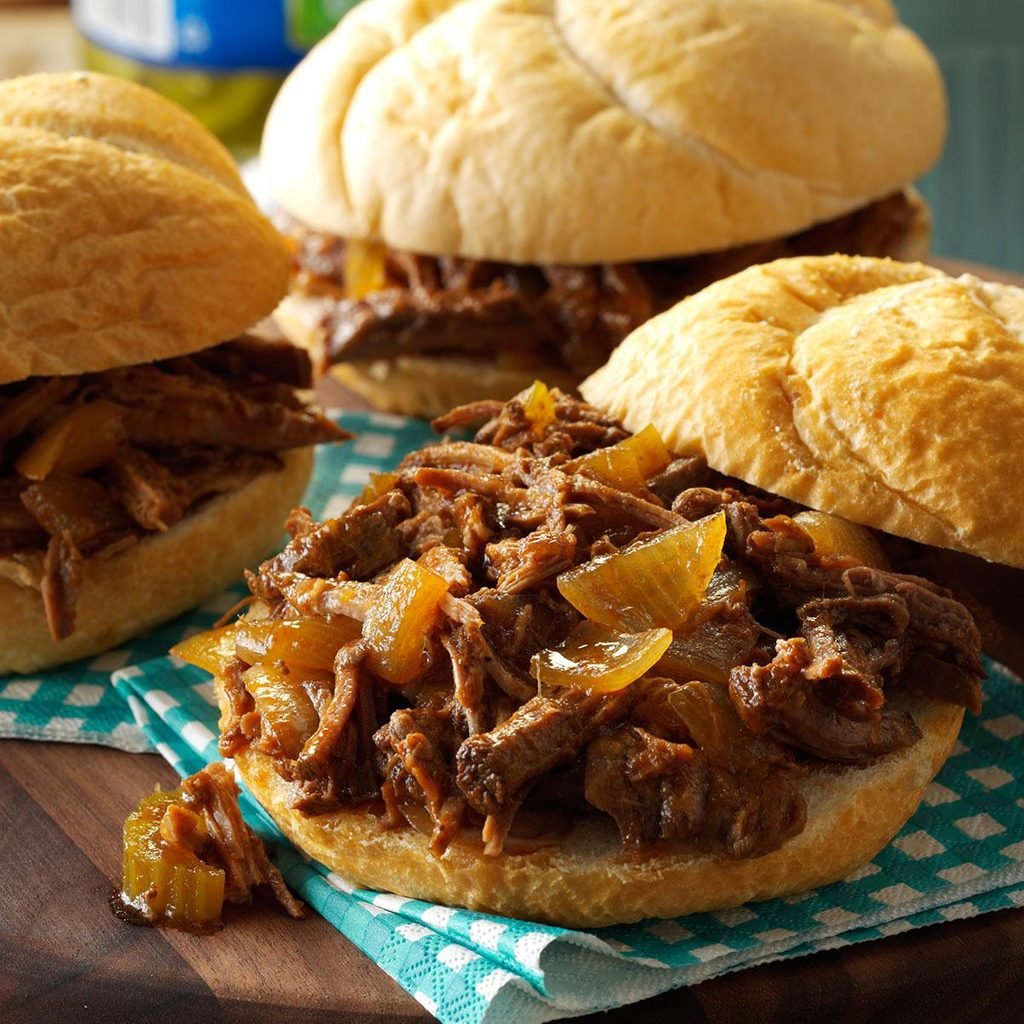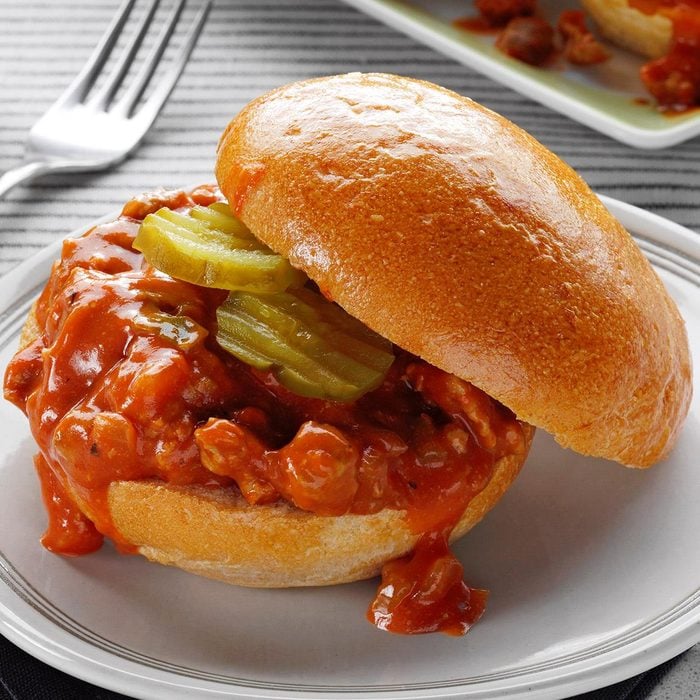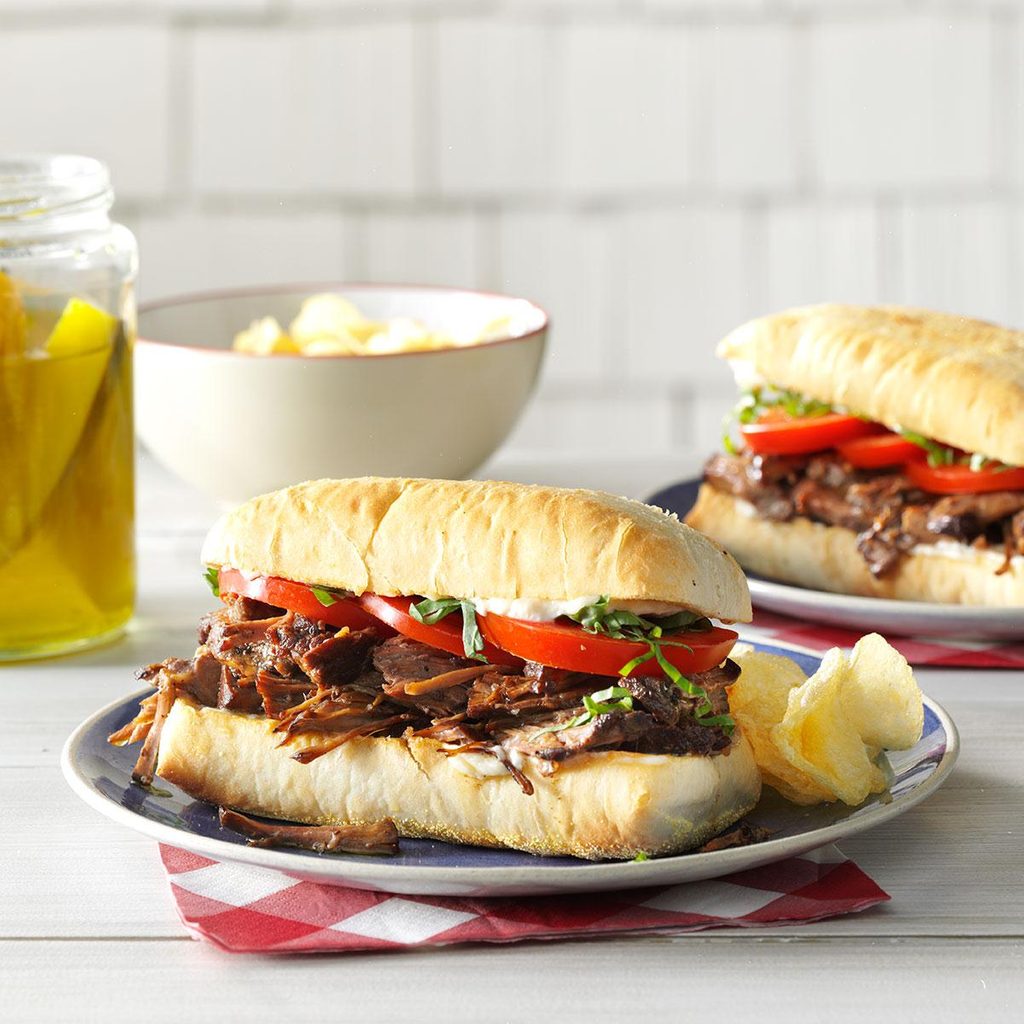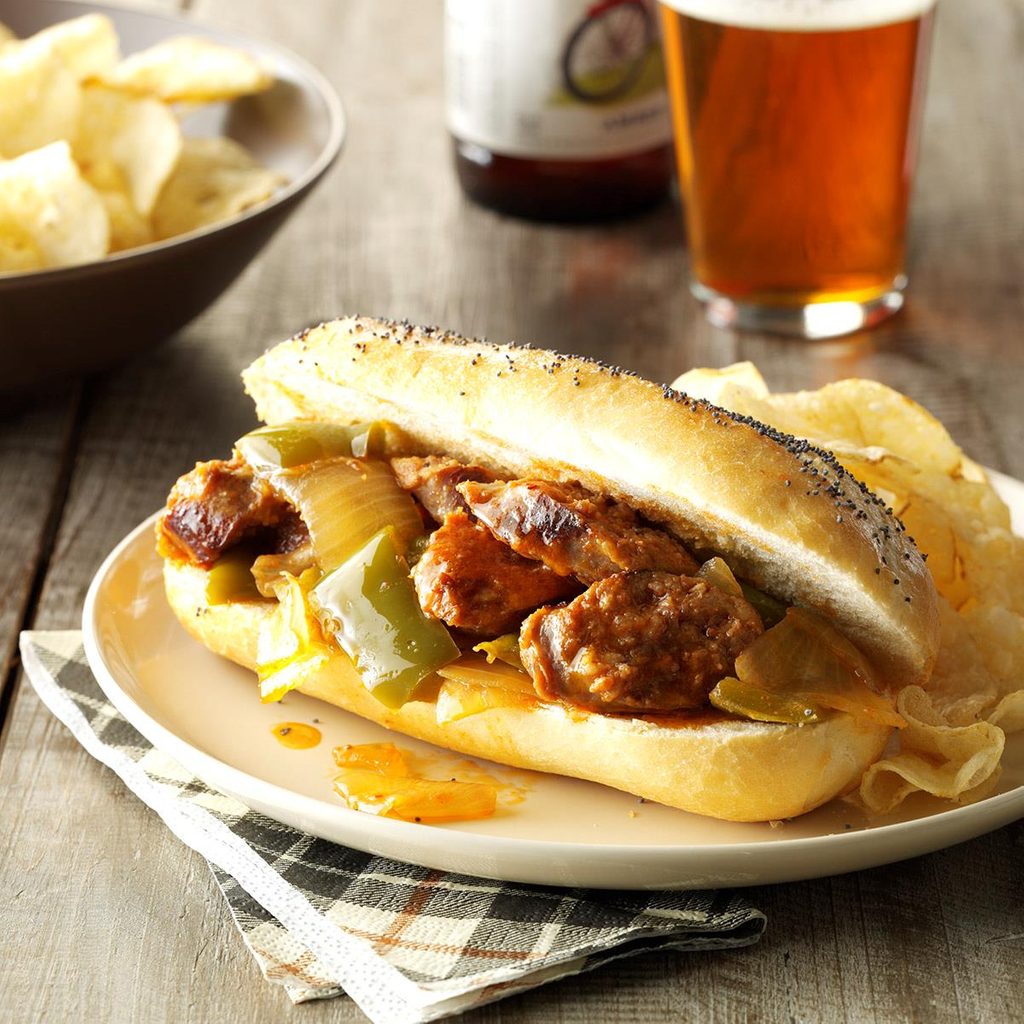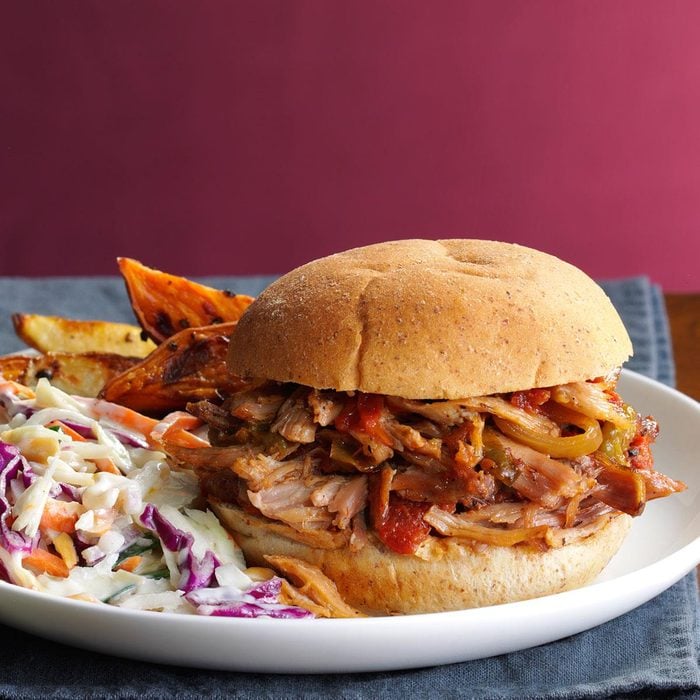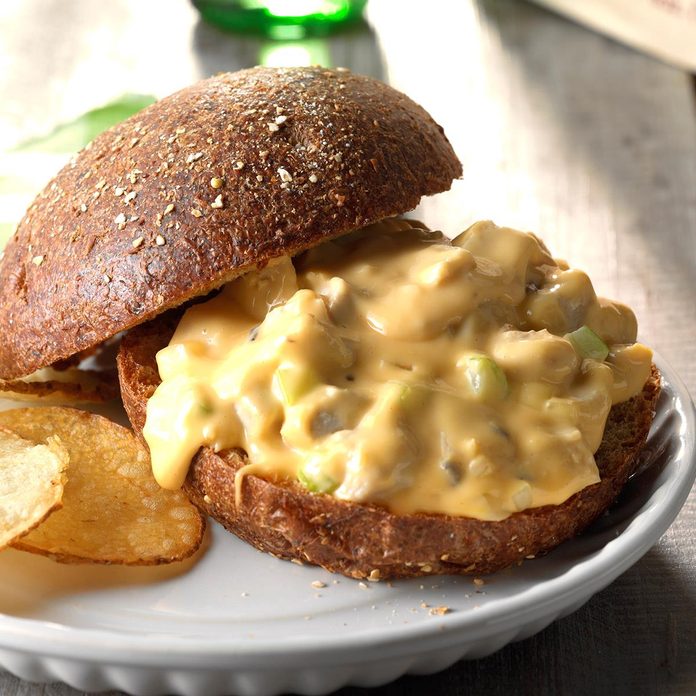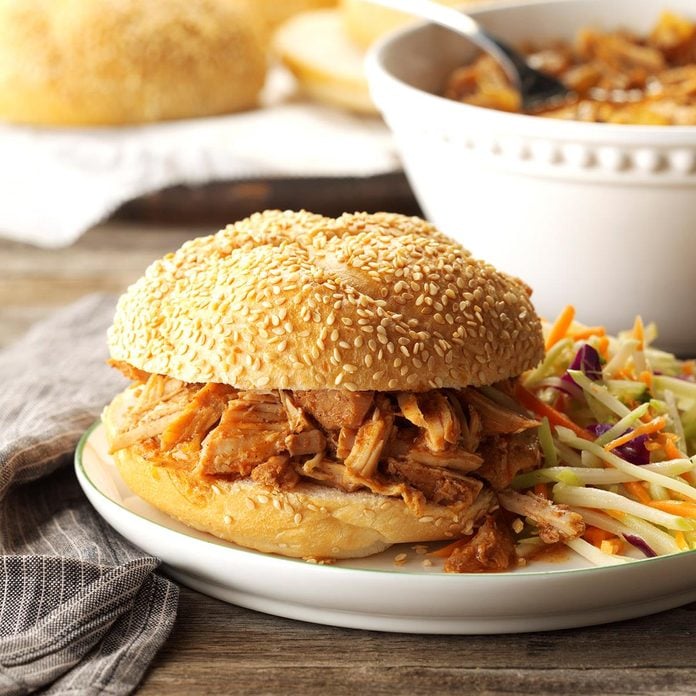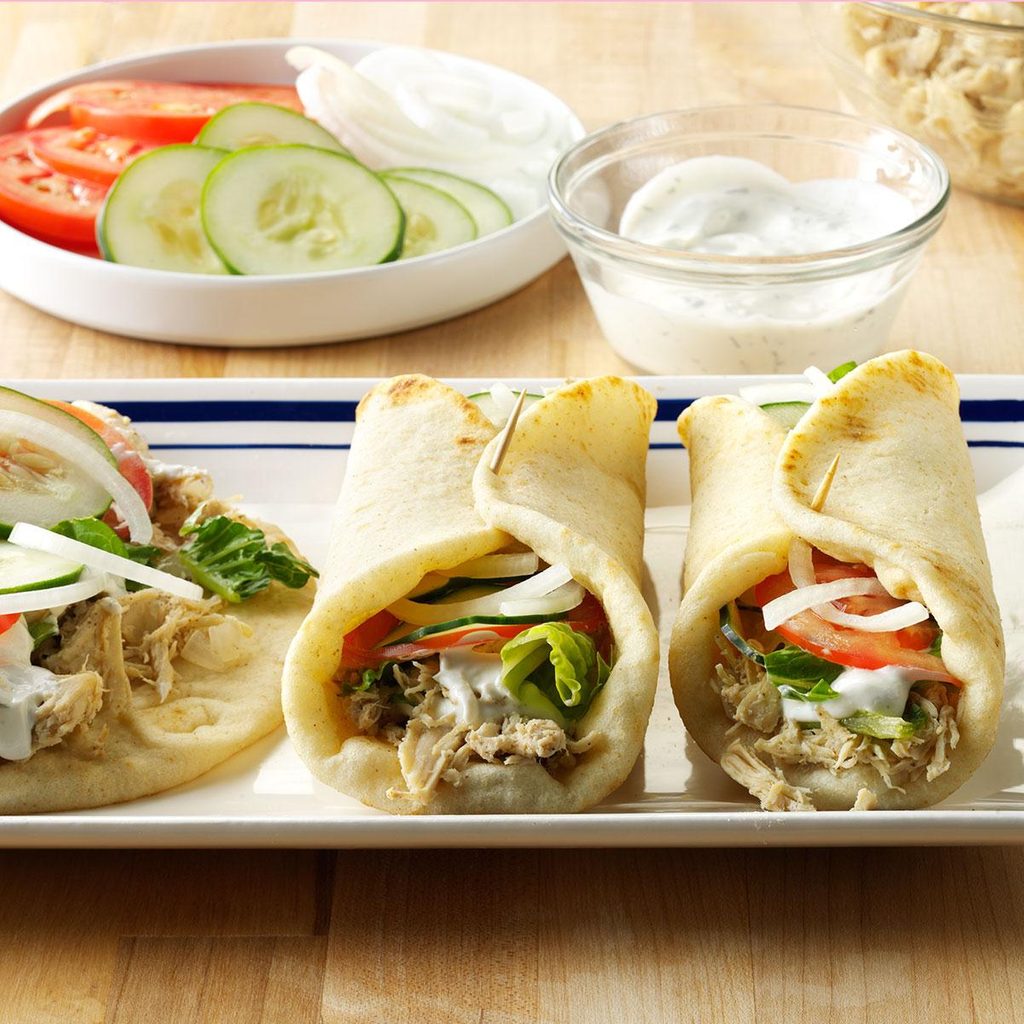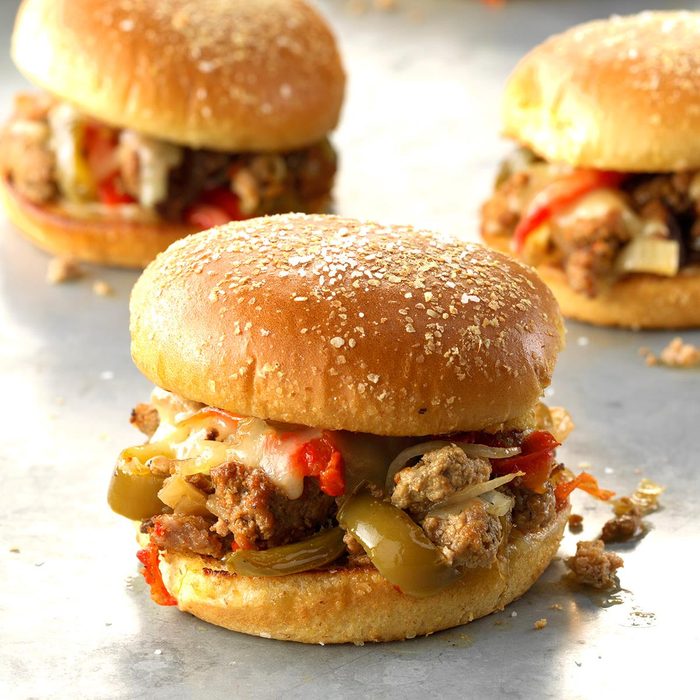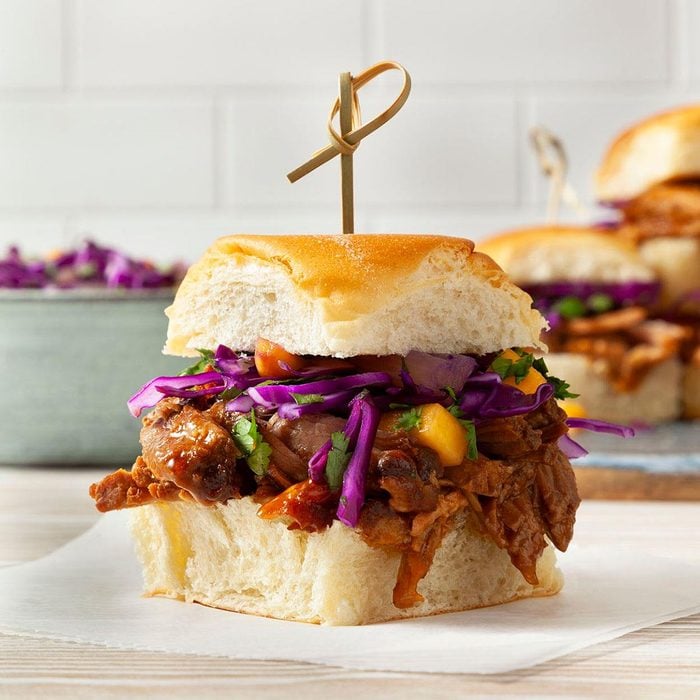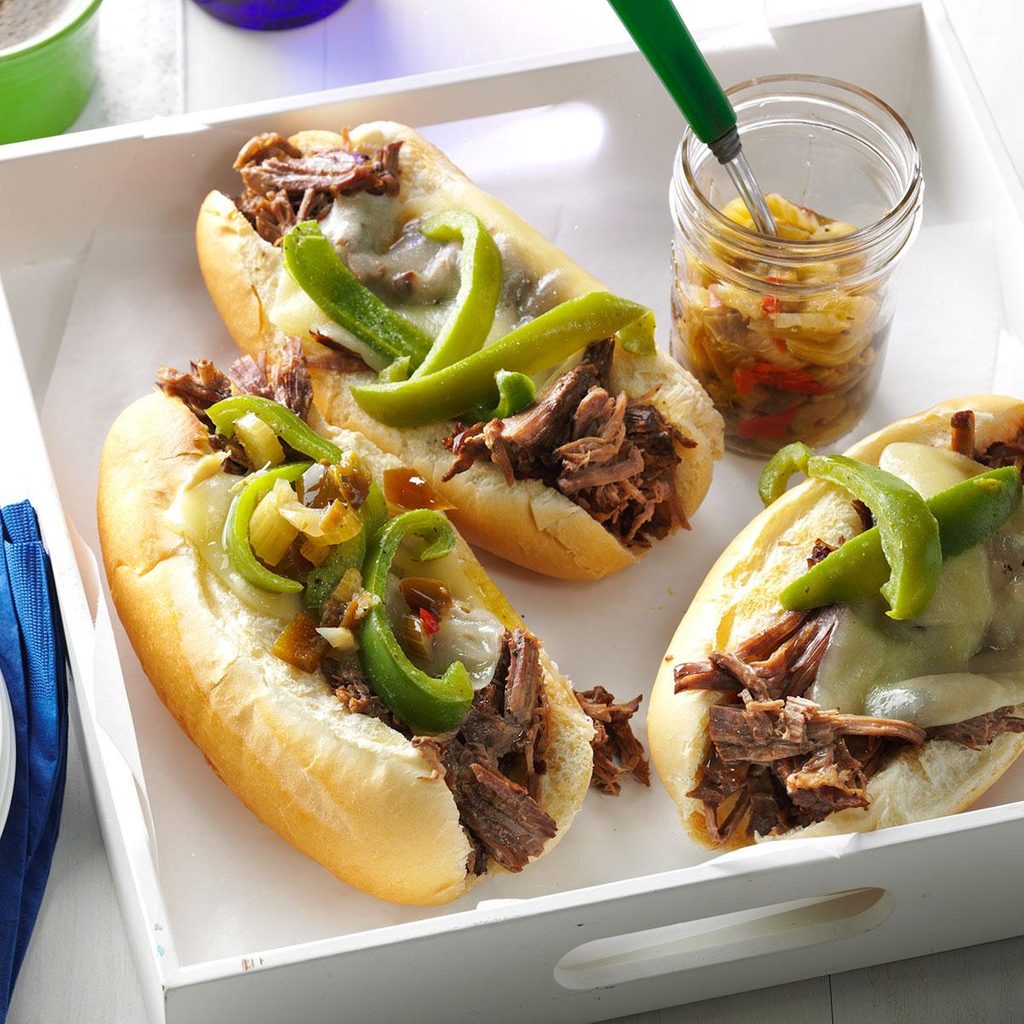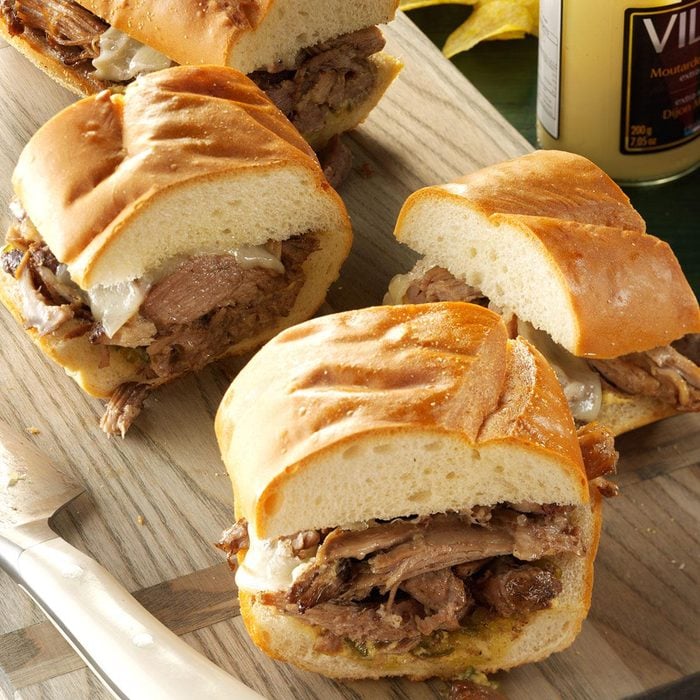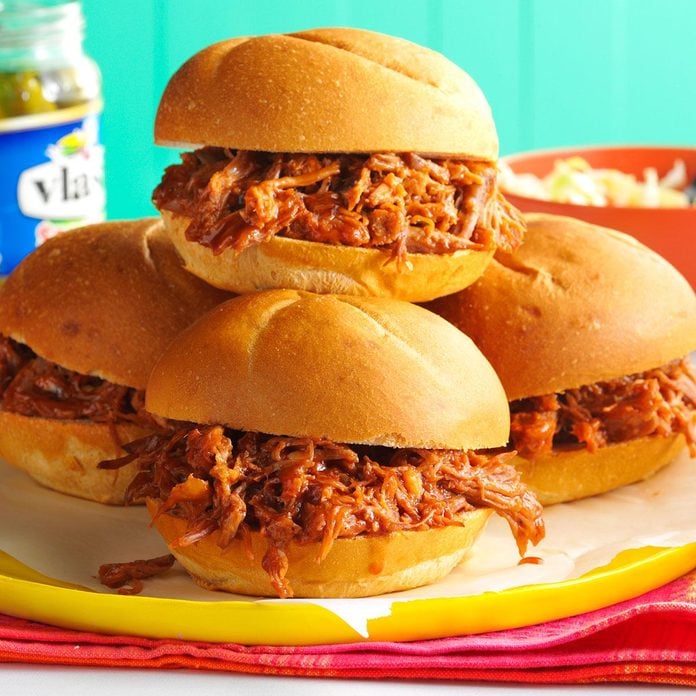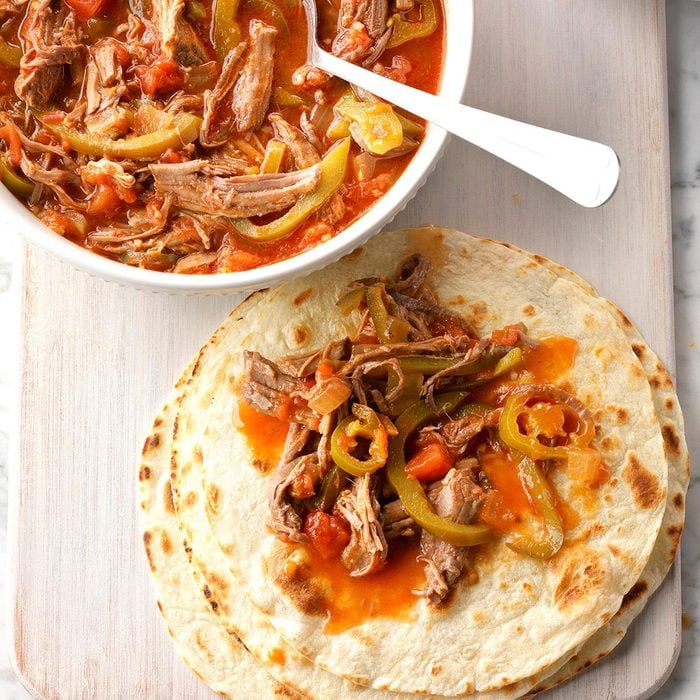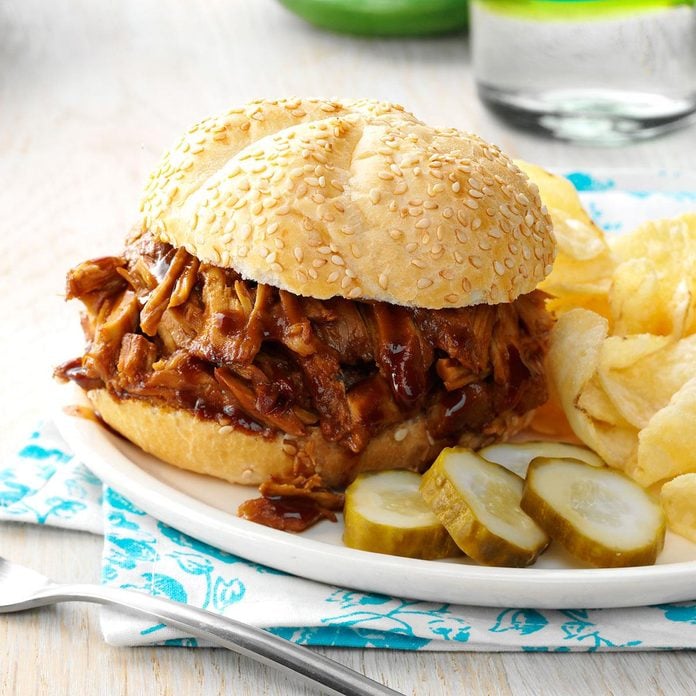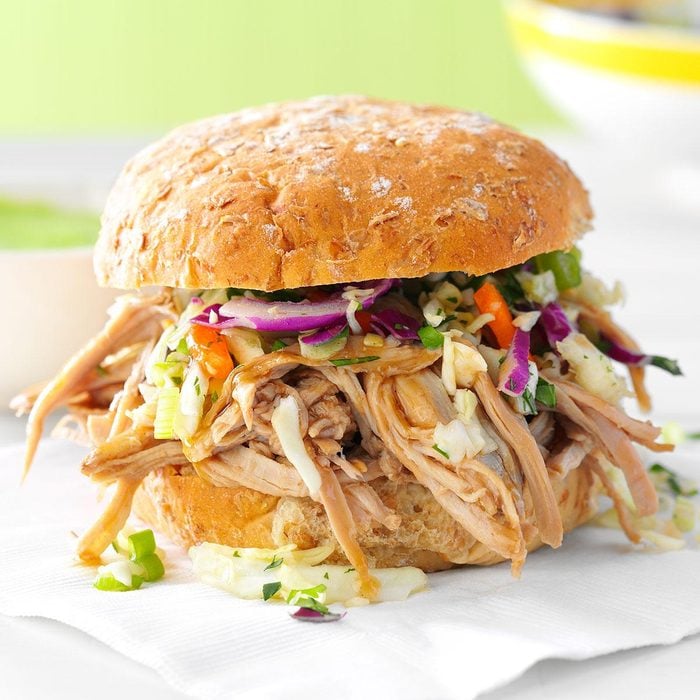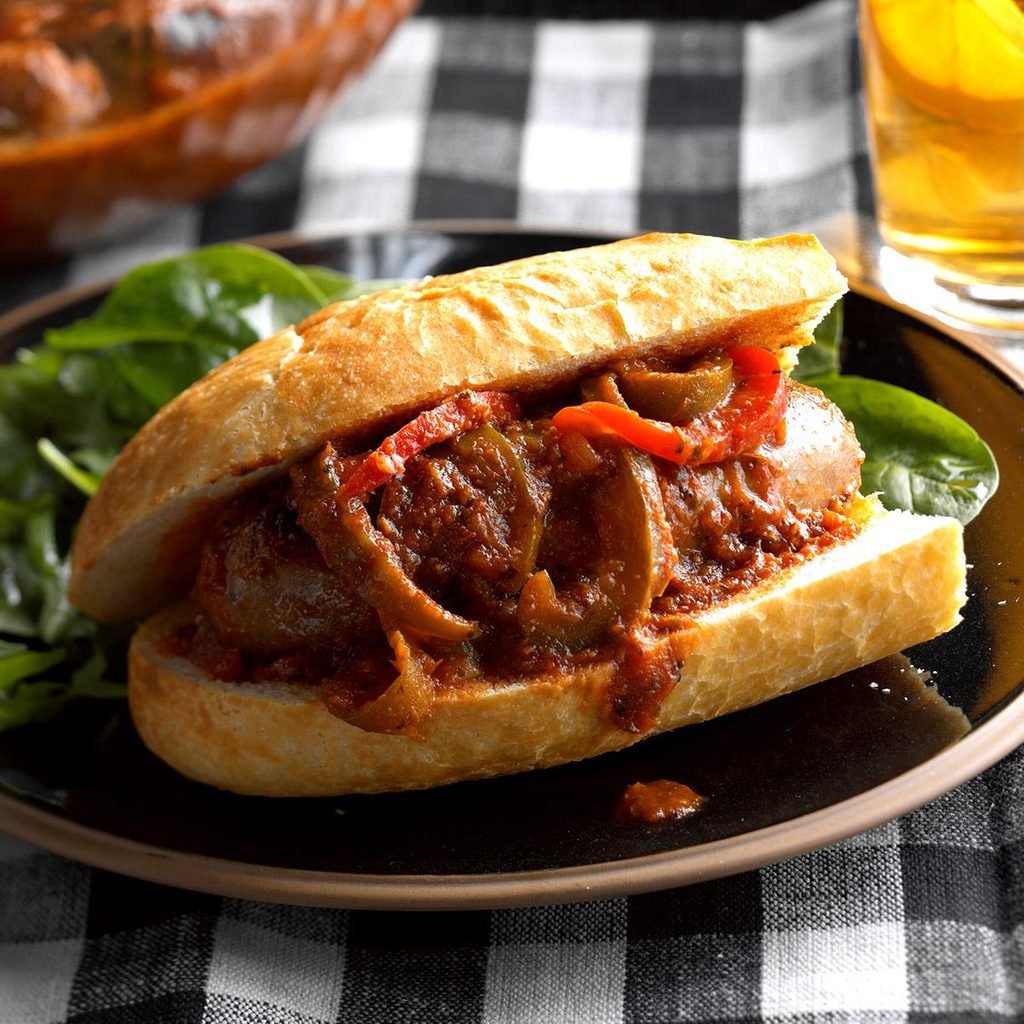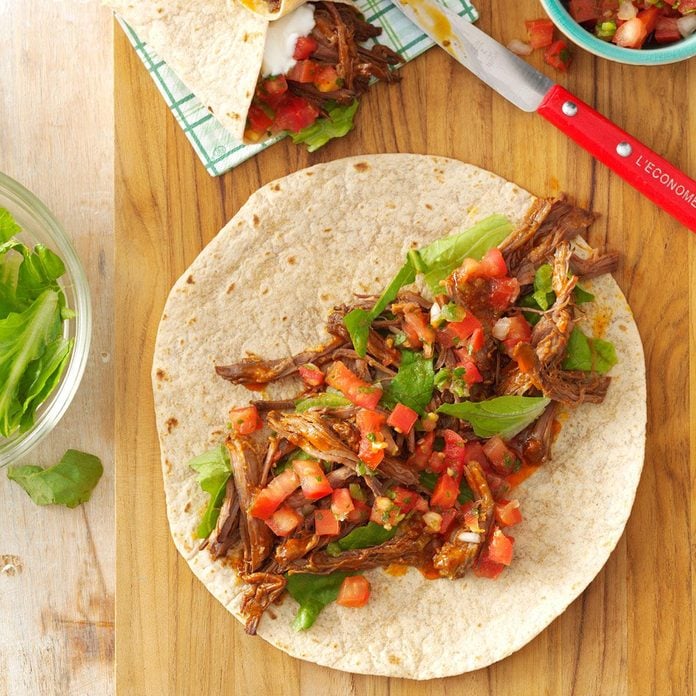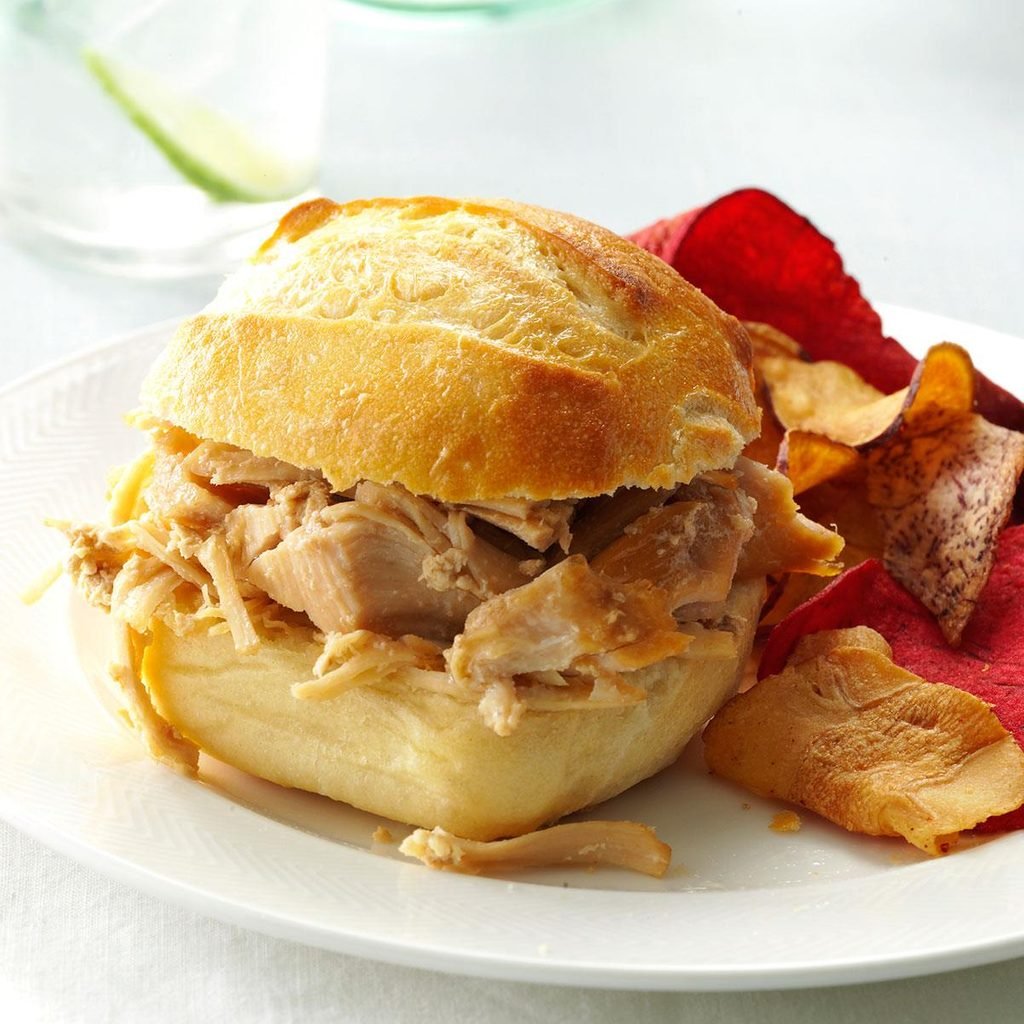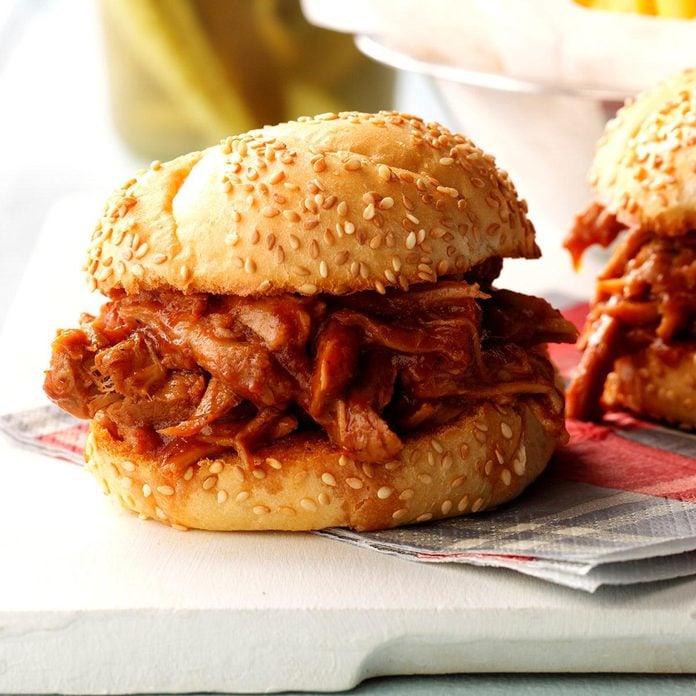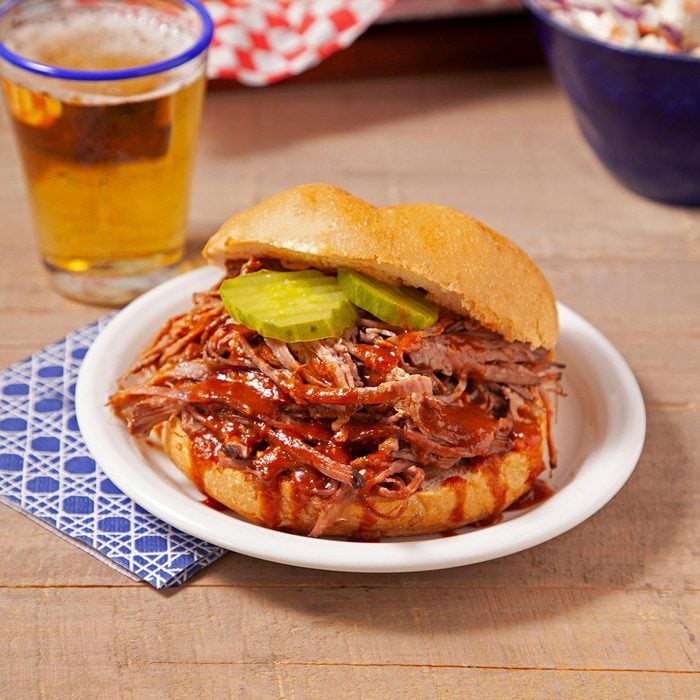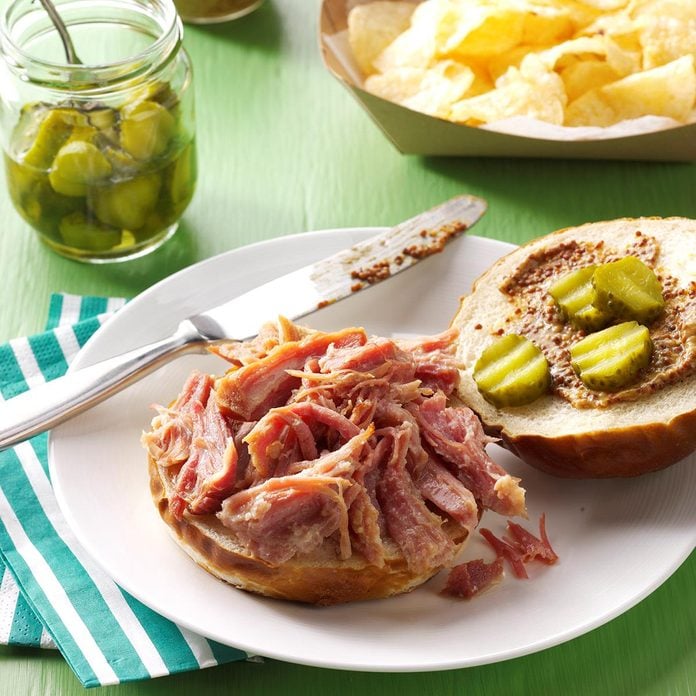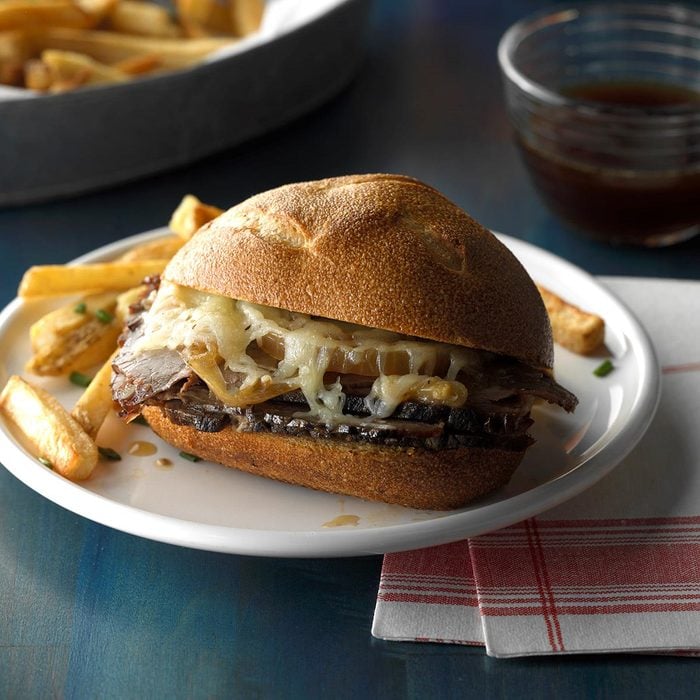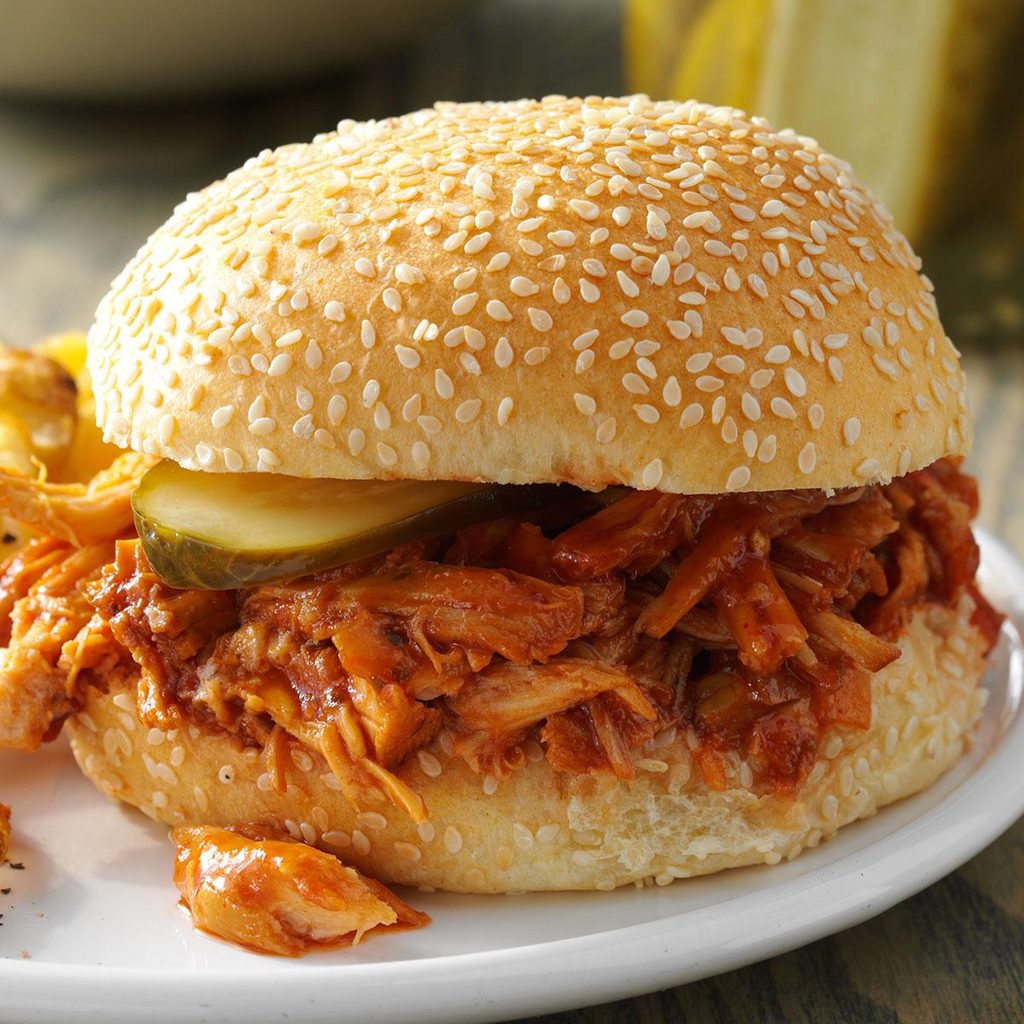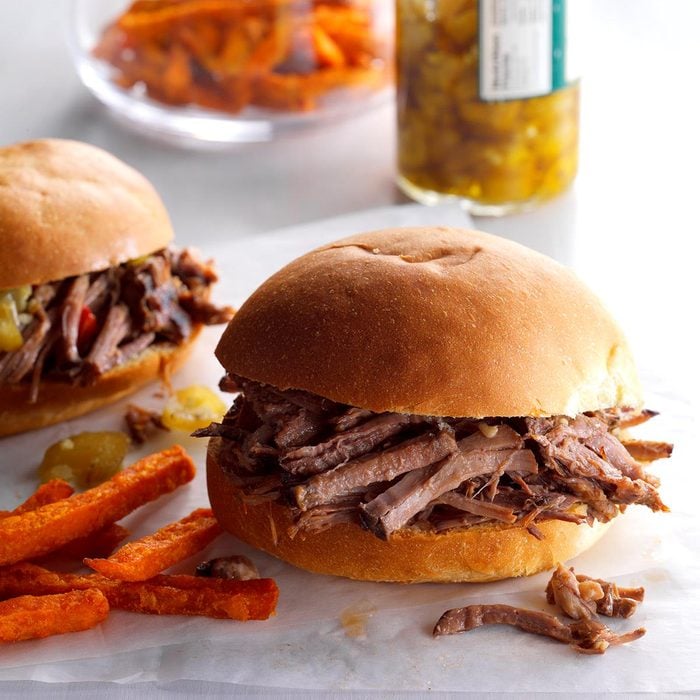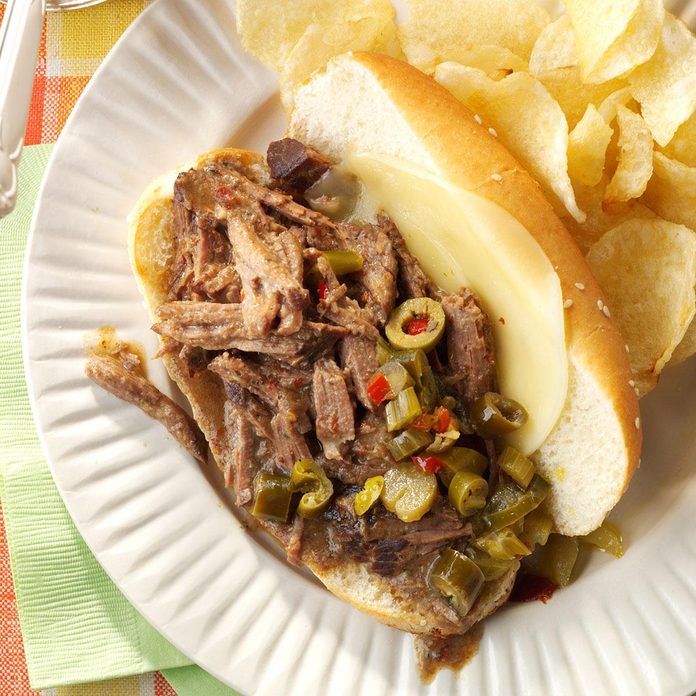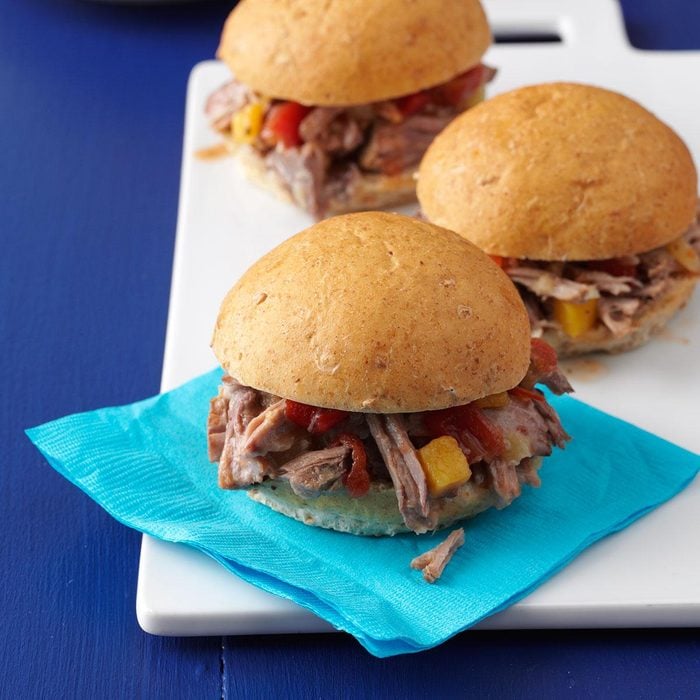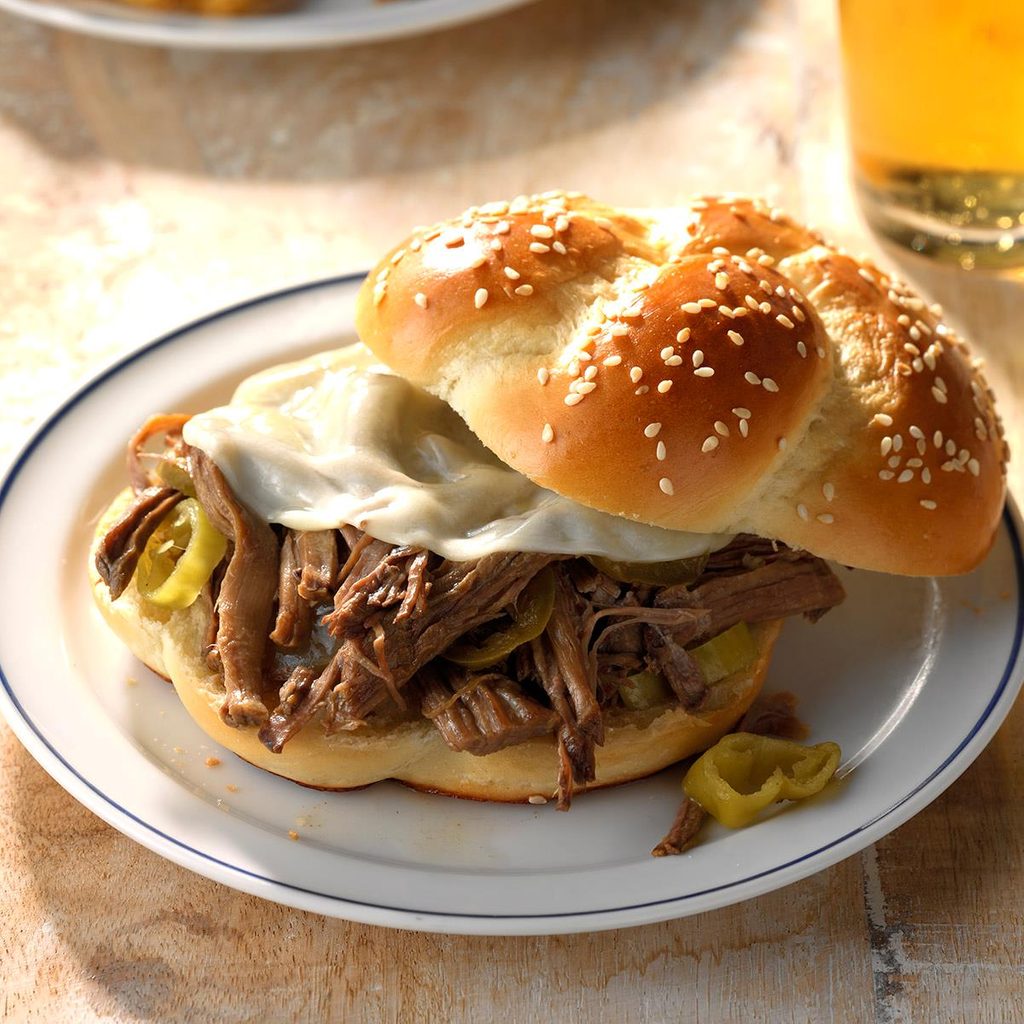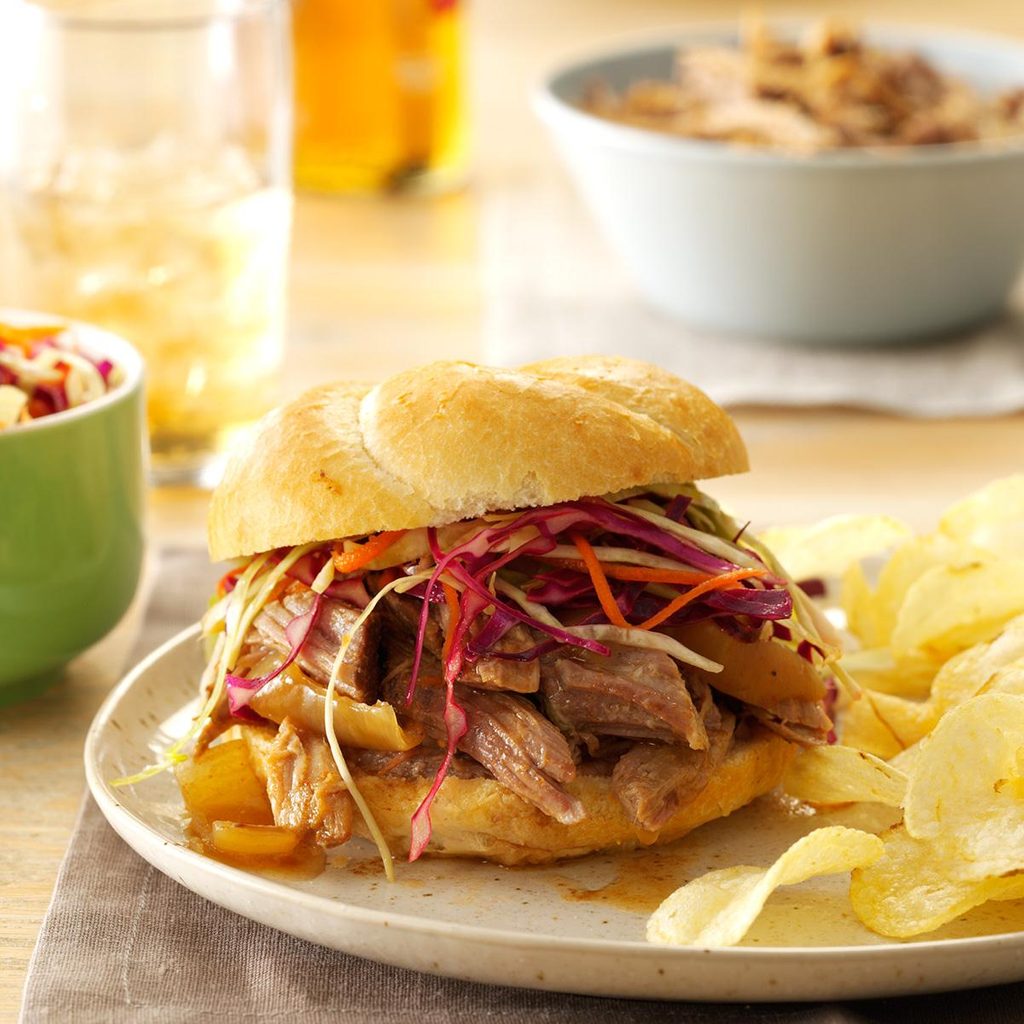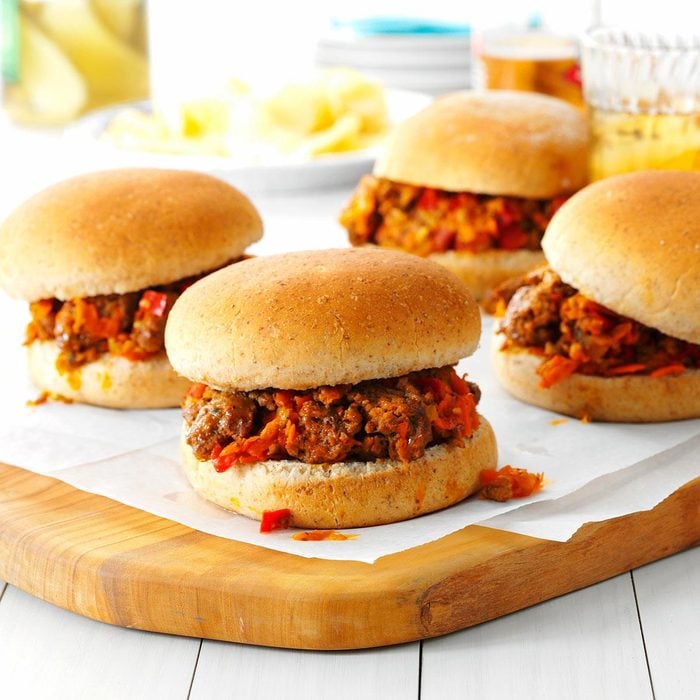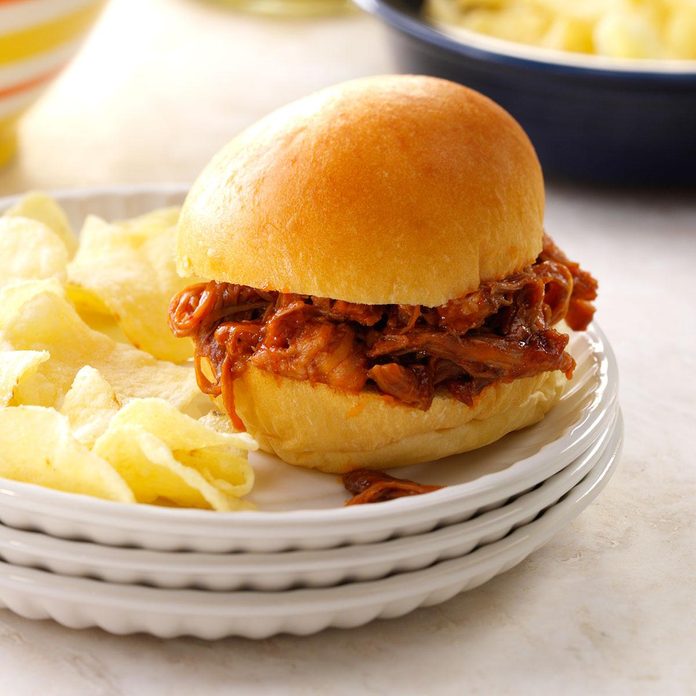Honey Pulled Pork SubsHoney and ground ginger are the flavor boosters behind my no-stress sandwiches. A bottle of barbecue sauce ties it all together in a pinch. —Denise Davis, Porter, Maine
Brats with SauerkrautI’ve made many variations of this excellent main dish. It would be popular at a party or potluck. The bratwurst can be plain, smoked or cheese-flavored and served whole or cut in slices, with a bun or without. —Darlene Dixon, Hanover, Minnesota
Coffee-Braised Pulled Pork SandwichesAdding coffee to meat adds such a deep flavor. And this recipe is so easy—I put it in before work, and by the time we all get home, it's ready for us to dig in. —Jacquelynn Sanders, Burnsville, Minnesota
Texas Beef BarbecueA boneless beef roast simmers for hours in a slightly sweet sauce before it's shredded and tucked into rolls to make hearty sandwiches. This is a family favorite. —Jennifer Bauer, Lansing, Michigan
Meat Loaf BurgersThese hearty meat loaf sandwiches are delightful for potluck dinners. Served on hamburger buns, the beefy patties get extra flavor when topped with the seasoned tomato sauce. —Peggy Burdick, Burlington, Michigan
Cranberry BBQ Pulled PorkCranberry sauce adds a yummy twist to pulled pork, and my family can't get enough of it! The pork cooks to tender perfection in the slow cooker, which also makes this dish conveniently portable. —Carrie Wiegand, Mount Pleasant, Iowa
Chicago-Style Beef RollsI have fond memories of eating these big, messy sandwiches at a neighbor's house when I was growing up. Freeze any extras and save for another meal! —Trisha Kruse, Eagle, Idaho
Shredded Pork BurritosThis pork roast is slow-cooked with savory and sweet ingredients, including a can of cola, to create tender shredded pork burritos. A tomatillo sauce, made easy with a dressing mix, tops the pork for an out-of-this-world entree. —Katherine Nelson, Centerville, Utah
Slow-Cooker Meatball SandwichesOur approach to meatball sandwiches is a simple one: Cook the meatballs low and slow, load them into hoagie buns, and top them with provolone and pepperoncini. —Stacie Nicholls, Spring Creek, Nevada
Blackberry Sriracha Chicken SlidersDump everything in a slow cooker and then watch these spicy-sweet sliders become an instant party-time classic. —Julie Peterson, Crofton, Maryland
Cuban-Style Pork SandwichesLoaded with tangy flavor, this is a lighter version of a favorite restaurant-style sandwich. If you don’t have a panini maker, tuck the sandwiches under the broiler until the bread is browned and the cheese melted. —Robin Haas, Cranston, Rhode Island
Melt-in-Your-Mouth SausagesMy family loves this recipe. It’s such a good all-around dish, either for sandwiches like these or served with hot spaghetti. —Ilean Schultheiss, Cohocton, New York
Easy Philly CheesesteaksSince we live in a rural area where there aren’t any restaurants to speak of, I thought it would be fun to make this classic sandwich at home. For an extra flavor boost, add a splash of steak sauce. —Lenette Bennett, Como, Colorado
Shredded Steak SandwichesI received this recipe when I was a newlywed, and it's been a favorite since then. The saucy steak barbecue makes a quick meal served on sliced buns or even over rice, potatoes or buttered noodles. —Lee Deneau, Lansing, Michigan
Slow-Cooked Turkey Sloppy JoesThis tangy sandwich filling is easy to prepare in the slow cooker, and it goes over so well at gatherings large and small. I frequently take it to potlucks, and I'm always asked for my secret ingredient! —Marylou LaRue, Freeland, Michigan
Bandito Chili DogsThese deluxe chili dogs are a surefire hit at family functions. Adults and children alike love the cheesy chili sauce, and the toppings are fun! —Marion Lowery, Medford, Oregon
Balsamic Beef HoagiesAll my boys (big and small) like sandwiches, and balsamic beef is a welcome change from pulled barbecue chicken. We use leftovers in quesadillas, on pizza or with rice. You can find more family-friendly recipes at my blog, theseasonedmom.com. —Blair Lonergan, Rochelle, Virginia
Sausage Pepper SandwichesPeppers and onions add fresh flavor to this sausage filling for sandwiches. It's simple to assemble, and it's always gobbled up quickly. —Suzette Gessel, Albuquerque, New Mexico
Italian Pulled Pork SandwichesEnjoy all the flavors of Italian sausage sandwiches with this healthier alternative. —Lia Dellario, Middleport, New York
Slow-Cooked Turkey SandwichesThese sandwiches have been such a hit at office potlucks that I keep copies of the recipe in my desk to hand out. —Diane Twait Nelsen, Ringsted, Iowa
Barbecue Brats & PeppersWe live in brat country, and this barbecue-style recipe feeds a crowd. The sauce gives it a welcome change from the same old grilled bratwurst. — Maria Zrucky, Kronenwetter, Wisconsin
Country Rib SandwichesPerfect for a weekday dinner or cozy weekend meal, this recipe makes fall-off-the-bone tender meat with delicious flavor. —Margaret Luchsinger, Jupiter, Florida
Shredded Chicken GyrosOur family always has such a wonderful time at the annual Salt Lake City Greek Festival. One of my favorite parts is all the awesome food. This meal is a good way to mix up our menu, and my kids are big fans. —Camille Beckstrand, Layton, Utah
Hearty Italian SandwichesI've been making this sweet and spicy sandwich filling for 35 years. It smells as good as it tastes! It's a great reward for a hungry family after a day working or playing outdoors. —Elaine Krupsky, Las Vegas, Nevada
BBQ BratsIn Wisconsin, brats are a food group! We are always looking for new ways to cook them. This recipe is easy and a hit at any tailgate party or cookout, any time of year. —Jessica Abnet, DePere, Wisconsin
Caribbean Chipotle Pork SlidersOur favorite pulled pork sliders combine the heat of chipotle peppers with a cool tropical coleslaw. The robust flavors make these a big hit with guests. —Kadija Bridgewater, Boca Raton, Florida
Slow-Cooker Italian Beef SandwichesI have fond memories of my mother in the kitchen preparing her amazing beef dip sandwiches. They always made our house smell like an Old World Italian restaurant. And as good as the aroma was, somehow the taste was even better! Set out a jar of giardiniera for spooning on top. —Kira Vosk, Milwaukee, Wisconsin
Cubano Pork SandwichesWhen a hungry crowd is coming over, we plan to make our juicy pork a day ahead. I call the sauce "Mojo" because it’s loaded with zingy flavors. —Theresa Yardas, Sheridan, Indiana
Buffalo Chicken SlidersI got the idea for these Buffalo chicken sliders from my mom and dad, who'd made a similar version for a family get-together. It's a versatile recipe, and I sometimes use several different styles of Buffalo sauce and let guests mix and match their favorites. —Christina Addison, Blanchester, Ohio
Best Italian Sausage SandwichesNeed a different type of Italian dinner? This rich tomato sauce simmers all afternoon in the slow cooker, ready to top freshly grilled Italian sausages. It's a fantastic combination with lots of crowd appeal! —
Taste of Home Test Kitchen
Root Beer Pulled Pork SandwichesMy husband is a huge fan of pulled pork sandwiches, so my sister shared this incredibly easy recipe with me. At potlucks and family dinners, nobody can get enough of this root beer-braised version. —Carolyn Palm, Radcliff, Kentucky
Italian Beef on RollsThis slow-cooker recipe is one of my all-time favorites! With 29 grams of protein per serving, it’s a great way to meet your daily needs. —Jami Hilker, Harrison, Arkansas
Southwestern Beef TortillasBeef chuck roast makes a savory filling in satisfying tortillas. Cooked to tender perfection in the slow cooker, the beef is treated to an easy and delicious jalapeno-flavored sauce. —Marie Rizzio, Interlochen, Michigan
Slow-Cooker Pulled Pork SandwichesI like to share this dish at potlucks because it can be made ahead, which I especially appreciate during the busy holiday season. The sweet-and-spicy sauce is always a hit. —Martha Anne Carpenter, Mesa, Arizona
Polynesian Pulled ChickenI love the aroma of pork as it cooks but don't eat pork, so I make a pulled chicken with coconut and pineapple for a Polynesian twist. —Becky Walch, Manteca, California
Pork and Beef BarbecueIt's the combination of beef stew meat and tender pork that keeps friends and family asking for these tangy sandwiches. Add a little lettuce and tomato for a crisp contrast. —Corbin Detgen, Buchanan, Michigan
Slow-Cooked Reuben BratsSauerkraut gives these beer-simmered brats a big flavor boost, but it’s the special chili sauce and melted cheese that put them over the top. Top your favorite burger with some of the chili sauce; you won't be sorry. —Alana Simmons, Johnstown, Pennsylvania
Sesame Pulled Pork SandwichesI wanted to build a better pork sandwich, and this Asian-style filling was a huge hit with my husband and coworkers. Bring on the wasabi mayo. —Jennifer Berry, Lexington, Ohio
Italian Sausage HoagiesIn southeastern Wisconsin, our cuisine is influenced by both Germans and Italians who immigrated to this area. When preparing this recipe, we often substitute German bratwurst for the Italian sausage, so we blend the two influences with delicious results. —Craig Wachs, Racine, Wisconsin
Mexican Shredded Beef WrapsThe first time I served these wrap sandwiches was at the party following my son’s baptism. Everyone liked them so much that it’s become one of my go-to slow-cooker recipes. —Amy Lents, Grand Forks, North Dakota
Chili Coney DogsFrom the youngest kids to the oldest adults, everyone in our family loves these hot dogs. Inspired by the classic Coney dog, they’re so easy to throw together in the morning or even the night before. —Michele Harris, Vicksburg, Michigan
Slow Cooker Shredded Turkey SandwichesThis easy and simple slow-cooked sandwich gets its flavor from bottled beer and onion soup mix. In total, it only takes five ingredients to make the recipe! —Jacki Knuth, Owatonna, Minnesota
Tangy Pulled Pork SandwichesThe slow cooker not only makes this an easy meal, it keeps the pork tender, saucy and loaded with flavor. —Beki Kosydar-Krantz, Mayfield, Pennsylvania
BBQ Chicken SlidersBrining the meat overnight helps make these BBQ chicken sliders taste exceptionally good. Plus, they're so tender, they melt in your mouth. —Rachel Kunkel, Schell City, Missouri
Contest-Winning Bavarian Meatball HoagiesWhen my husband is not manning the grill, I count on my slow cooker. These meatballs are a guaranteed crowd-pleaser when I serve them as a party appetizer or spooned over crusty rolls and topped with cheese for irresistible sandwiches. —Peggy Rios, Mechanicsville, Virginia
Pulled Brisket SandwichesDon't let the number of ingredients in this brisket sandwich recipe scare you; you probably have most of them in your pantry already. The sauce is what makes this dish so special. It's hard not to like ketchup, brown sugar and a little butter drizzled over tender beef brisket. —Jane Guilbeau, New Orleans, Louisiana
Beer-Braised Pulled HamTo jazz up ham, I slow-cooked it with a beer sauce. Buns loaded with ham, pickles and mustard are irresistible. —Ann Sheehy, Lawrence, Massachusetts
French Dip Sandwiches with OnionsWhen I want to impress company, these satisfying sandwiches are my first pick for the menu. I serve them au jus, with the cooking juices in individual bowls for dipping. —Florence Robinson, Lenox, Iowa
Chipotle Pulled ChickenAt our house, low-and-slow recipes have to have kid and husband appeal, plus good marks for nutrition. This chipotle chicken wins in both categories. Use leftovers for zippy barbecue pizzas or burritos. —Tamra Parker, Manlius, New York
Dilly Beef SandwichesMy younger sister shared this recipe with me. It puts a twist on the traditional barbecue sandwich and is a proven crowd-pleaser. Plus, it's incredibly convenient to make in the slow cooker. —Donna Blankenheim, Madison, Wisconsin
Honey Buffalo Meatball SlidersThese little sliders deliver big Buffalo chicken flavor without the messiness of wings. The spicy-sweet meatballs are a hit on game day with kids and adults alike. —Julie Peterson, Crofton, Maryland
Slow-Cooker Italian Beef SandwichesMy mom made the best Italian beef. I’ve added to it over the years, but it’s still her recipe. She made these Italian beef sandwiches for family reunions, and there were never leftovers. —Mary McVey, Colfax, North Carolina
Tropical Pulled Pork SlidersI used what I had in my cupboard to make this pork, and the results were fantastic! I enjoy transforming an inexpensive cut of meat to something extraordinary. —Shelly Mitchell, Gresham, Oregon
Spicy Shredded Beef SandwichesIf you like your shredded beef with a little kick, then this recipe is for you. For an even zestier version of this recipe, add another jar of jalapenos or use hot peppers instead of the pepperocinis. —Kristen Langmeier, Faribault, Minnesota
Chicken Sliders with Sesame SlawEveryone loves barbecue chicken sliders. My version has an Asian twist, with spicy, tangy flavors. At our potlucks, they quickly vanish. —Priscilla Yee, Concord, California
Sweet & Spicy Pulled Pork SandwichesI threw some always-available condiments into my slow cooker with a pork roast to create this fantastic pulled pork. It has become a staple sandwich filler for large get-togethers. The flavor of the pork goes well with a cold glass
of white wine.—Lori Terry, Chicago, Illinois
Hawaiian Kielbasa SandwichesIf you are looking for a different way to use kielbasa, the sweet and mildly spicy flavor of these sandwiches is a nice change.—Judy Dames, Bridgeville, Pennsylvania
Beef & Veggie Sloppy JoesI’m always looking for ways to serve my family healthy and delicious food, so after I started experimenting with my favorite veggies and ground beef. I came up with this favorite that my three kids actually request! This healthy take on sloppy joes reminds me of my own childhood. —Megan Niebuhr, Yakima Washington
Sweet & Smoky Pulled Pork SandwichesMy primo pork is smoky, tender and tastes like it came from a barbecue joint. Without much help from me, it basically shreds itself. —Lauren Adamson, Layton, Utah

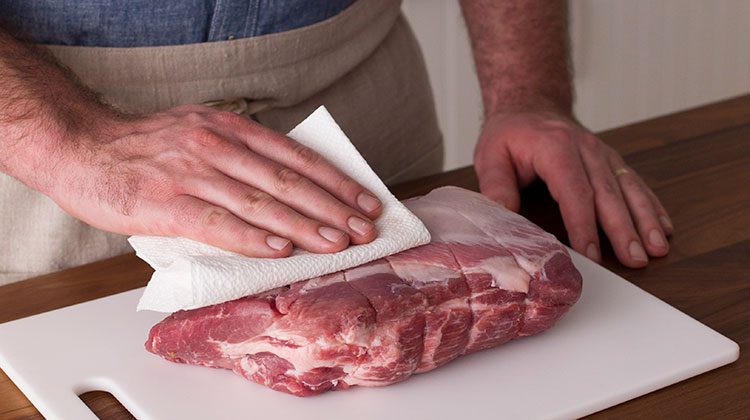 Step 2: Brown the Meat
Step 2: Brown the Meat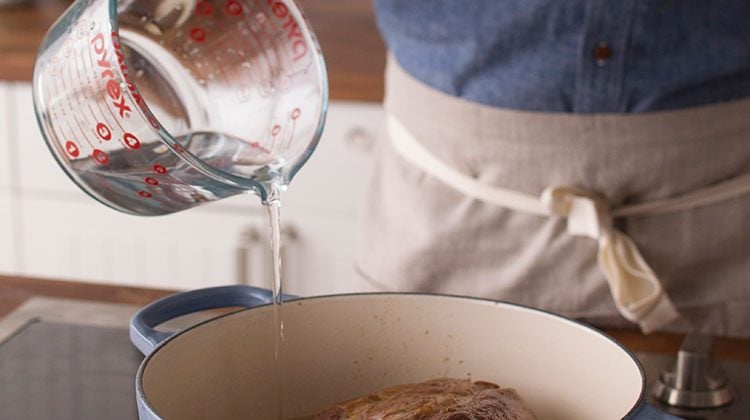 Step 4: Add Meat and Liquid
Step 4: Add Meat and Liquid